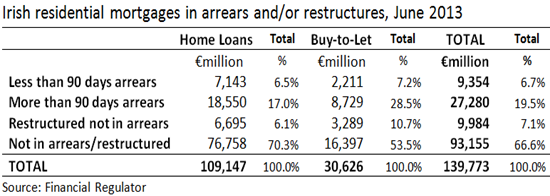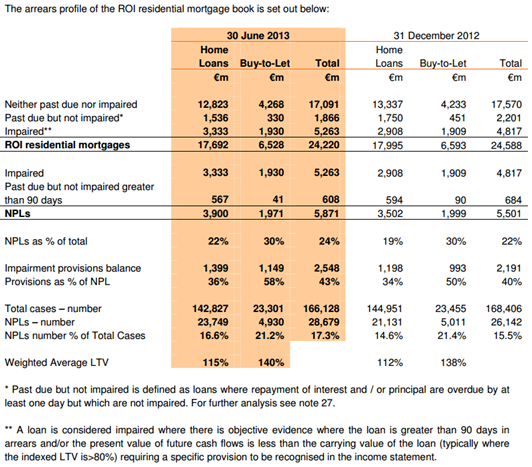The level of arrears in the quarterly statistics produced by the Financial Regulator continues to climb. The latest figures are for Q2 2013 (30 June) and this is the bleak picture they paint for the €140 billion Irish residential mortgage market. 
Only two-thirds of mortgages are being repaid under the terms of the original mortgage contract. Immediate concern can be directed at the €27.3 billion (19.5%) of mortgages that are at least 90 days in arrears (of which around two-thirds are actually more than 360 days in arrears).
Solving the problem at the level of the borrower should be the priority but a related issue at the level of the bank is whether this level of mortgage delinquency will lead to a further recapitalisation requirement for the covered* banks – and more specifically whether it will lead to one that has to be filled by the State.
[* The group of banks was called ‘covered’ because they were the banks covered by the bank guarantee introduced in September 2008. The original guarantee expired as planned in September 2010 and the Eligible Liabilities Guarantee (ELG) introduced in January 2010 was phased out this year. Although the guarantees are no more the covered grouping is still used here to represent the domestic banks the State has an ownership interest in.]
The remaining covered banks are Allied Irish Bank (now merged with the Educational Building Society, EBS), Bank of Ireland and Permanent TSB. Irish Nationwide Building Society and Anglo Irish Bank were originally part of the covered group but they merged to form the Irish Bank Resolution Corporation which was subsequently liquidated in February of this year. Irish Nationwide had around €1.8 billion of mortgages while Anglo had no mortgage book of note.
AIB and PTSB are almost fully state-owned while there is a 15% public ownership in BOI. Here are their mortgage books in this country (with the percentages representing the proportion of the overall market the banks have).
The first point to note is that €90 billion (64.5%) of the €140 billion across all mortgages are in the covered banks. The remaining €50 billion are banks in which the state has no ownership interest such as Ulster Bank, KBC Bank, Danske Bank while there are also the remnants of the loan books of lenders who have left the Irish market such as Bank of Scotland (Ireland), Start Mortgages and INBS as mentioned.
If not all of the mortgages are in the covered banks it stands to reason that not all of the mortgage arrears are in the covered banks. Here are the Irish mortgages in arrears of more than 90 days in the covered banks (with the percentages representing the proportion of non-performing loans the banks have).
[The figures come from the banks’ mid-year reports and also include loans which are impaired. In general, most of these will already by 90 days in arrears but a loan may be judged by the bank as impaired and not be 90 days in arrears because, for example, of concerns about loan-to-value levels.]
The covered banks had nearly €18 billion of impaired Irish mortgages at the 30 June 2013, with AIB’s buy-to-let loan book looking particularly bad with 48% in 90 day arrears and/or impaired.
In the case of AIB it should be noted that the current figures are for the combined AIB + EBS loan book. In December 2011, AIB home mortgage loans had 6.6% in arrears of 90 days or more, while for EBS the equivalent figure was 16.6%.
As a side note the last figures on the INBS mortgage book (June 2012) showed that €1.1 billion of the loans were past due and/or impaired – giving a non-performing rate of almost 60%.
What capacity do the remaining covered banks have to absorb losses on their mortgages? Again we can look to the banks’ financial reports and look at the stock of provisions they have on their balance sheets for losses on these loans (the percentage represents the amount of non-performing loans (NPLs) the banks have as a proportion of the totals in the previous table).
The banks have made a provision of almost 40% against their non-performing mortgages. The banks can cover over €7 billion of loan losses on their mortgages without having to make a charge on their income statement, reduce the carrying value of the loans and thus reduce their existing capital.
The rate of provisioning varies across the banks with AIB having set aside 33% of NPLs while the cover for PTSB is almost 50%.
The ability for the banks to be able to have such large provisions on their balance sheet is largely a result of the round of recapitalisation that took place following the PCAR results published in March 2011. The level of loss provisions the banks now have is fairly close to the Central Bank loss projections that the banks were recapitalised against at the time.
In the PCAR exercise, BlackRock Consultants came up with estimated lifetime losses that the banks might make on their loan books under both a ‘base’ and ‘stress’ scenario. The banks were recapitalised using the stress scenario with the Central Bank projecting “three-year losses” from the BlackRock figures for the recapitalisation requirement.
Here are the figures for Irish residential mortgages based on a December 2010 loan book of €98 billion meaning there has been a reduction in the outstanding amount of €8 billion in the past two and a half years. Most of that is because of capital repayments exceeding new drawdowns. Anyway here are the loss projections from the PCAR on the banks Irish residential mortgages.
The €16.3 billion of lifetime loan losses estimated by BlackRock under the ‘stress’ scenario was scaled to €9.0 billion of projected losses in the three year recapitalisation horizon used at the time by the Central Bank.
As we have seen the covered banks have €18 billion of mortgages in 90 day arrears and/or impaired. It would take a very large increase in this and a very low recovery rate (on repossessed properties) for €16.3 billion of losses to materialise.
It can be seen that the provisions for mortgage losses remaining on PTSB’s balance sheet is almost the same as the three-year loss projection used in the March 2011 PCAR (€2.55 billion provision now versus €2.59 billion projection then). The figures for BOI are reasonably close (€1.69 billion provision now versus €2.02 billion projection then) but their is a big game in AIB (€2.95 billion provision versus €4.39 billion projection). This likely reflects AIB’s less conservative provisioning highlighted above.
Should this divergence in the AIB figures be a concern? Possibly, but it is still a bit of a guess what the actual level of losses on Irish residential mortgages will be. The figures don’t have to be the same. The banks may have crystallised losses in the interim using some of their provisions. At a recent Oireachtas Committee hearing AIB confirmed that it had written down €93 million of mortgage debt over the past 18 months.
We know the banks have €7.2 billion of provisions set aside. The process that will result in these provisions being used for specific loans is, five years since the lending bubble burst, still uncertain.
With €9.8 billion of Core Tier 1 Capital, AIB has a CT1 rate of 15% so there is some buffer against losses in excess of those provided for. A return to operating profitability in the near future would also help.
The tables from each banks’ mid-year reports used in the above analysis are posted below the fold (click to enlarge).
Allied Irish Bank
Bank of Ireland
Permanent TSB
Tweet









From Brendan Burgess
ReplyDeleteHi Séamus
Excellent analysis. A few comments.
As we own AIB and ptsb 100%, and only 15% of Bank of Ireland, they should be looked at separately.
This is how I look at it
Total loans: €62 billion AIB: €38 billion; ptsb €24 billion
In arrears/impaired: €14 billion AIB: €9 billion; ptsb: €5 billion
Balance sheet provisions:€5.5 billion AIB:€3 billion; ptsb €2.5 billion
Pcar provisions: €7 billion AIB: €4.3 billion; ptsb: €2.6 billion
So the banks have been capitalised for €7 billion of losses on a €62 billion book, of which €14 billion is in arrears over 90 days.
Around 20% of mortgages in arrears are in positive equity.
So there is around €11 billion in arrears and in negative equity, for which €7 billion of capital has been provided.
With the threat or repossession now restored and the restrictions on banks in the Mortgage Arrears Code eased, I would expect that the level of arrears would beging to go down.
So it seems that €7 billion is plenty for the €11 billion.
I would think that the €30 billion of cheap trackers in AIB and ptsb might be a bigger source of concern. If they are losing 3% margin on these, that would be around €900 million a year, but gradually reducing. I understand, that no provision has been made for losses on these, as long as they are performing.
Thank you so much for listing these tables! I've been curious as to the financial positions of each one of these time periods. I find this extremely helpful and plan to reference these often. Not only that, but I love that they're from different countries! This really helps a lot! http://WWW.themortgagecentre-nealberta.ca
ReplyDelete